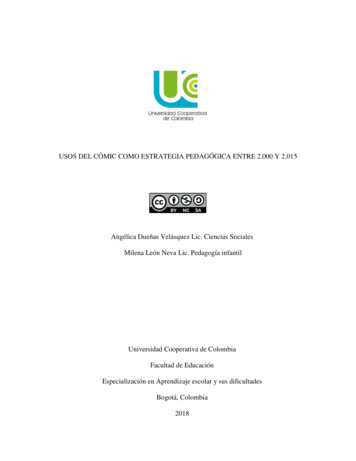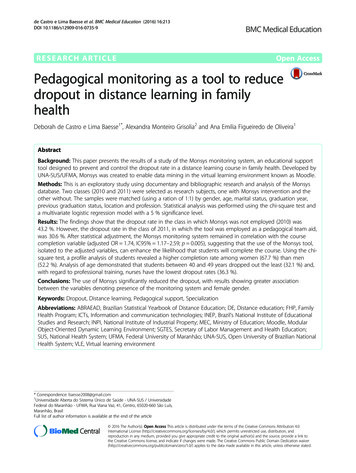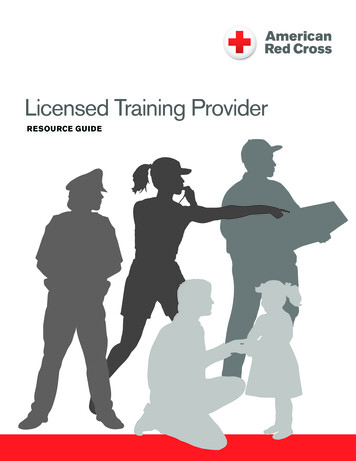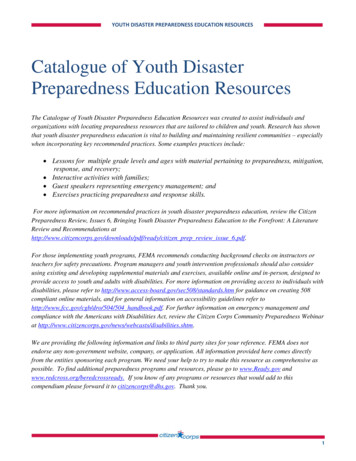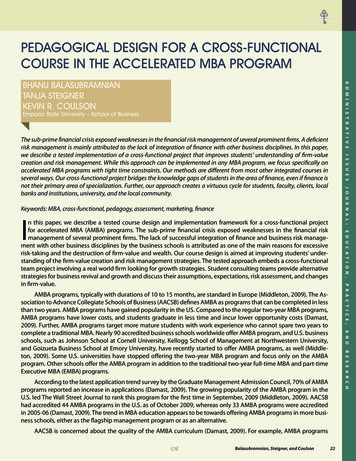
Transcription
PEDAGOGICAL DESIGN FOR A CROSS-FUNCTIONALCOURSE IN THE ACCELERATED MBA PROGRAMA D M I N I S T R A T I V EBHANU BALASUBRAMNIANTANJA STEIGNERKEVIN R. COULSONEmporia State University – School of BusinessI S S U E SThe sub-prime financial crisis exposed weaknesses in the financial risk management of several prominent firms. A deficientrisk management is mainly attributed to the lack of integration of finance with other business disciplines. In this paper,we describe a tested implementation of a cross-functional project that improves students’ understanding of firm-valuecreation and risk management. While this approach can be implemented in any MBA program, we focus specifically onaccelerated MBA programs with tight time constraints. Our methods are different from most other integrated courses inseveral ways. Our cross-functional project bridges the knowledge gaps of students in the area of finance, even if finance isnot their primary area of specialization. Further, our approach creates a virtuous cycle for students, faculty, clients, localbanks and institutions, university, and the local community.J O U R N A L :Keywords: MBA, cross-functional, pedagogy, assessment, marketing, financeIE d U C A T I O N ,n this paper, we describe a tested course design and implementation framework for a cross-functional projectfor accelerated MBA (AMBA) programs. The sub-prime financial crisis exposed weaknesses in the financial riskmanagement of several prominent firms. The lack of successful integration of finance and business risk management with other business disciplines by the business schools is attributed as one of the main reasons for excessiverisk-taking and the destruction of firm-value and wealth. Our course design is aimed at improving students’ understanding of the firm-value creation and risk management strategies. The tested approach embeds a cross-functionalteam project involving a real world firm looking for growth strategies. Student consulting teams provide alternativestrategies for business revival and growth and discuss their assumptions, expectations, risk assessment, and changesin firm-value.P R A C T I C E ,A N DAMBA programs, typically with durations of 10 to 15 months, are standard in Europe (Middleton, 2009). The Association to Advance Collegiate Schools of Business (AACSB) defines AMBA as programs that can be completed in lessthan two years. AMBA programs have gained popularity in the US. Compared to the regular two-year MBA programs,AMBA programs have lower costs, and students graduate in less time and incur lower opportunity costs (Damast,2009). Further, AMBA programs target more mature students with work experience who cannot spare two years tocomplete a traditional MBA. Nearly 90 accredited business schools worldwide offer AMBA program, and U.S. businessschools, such as Johnson School at Cornell University, Kellogg School of Management at Northwestern University,and Goizueta Business School at Emory University, have recently started to offer AMBA programs, as well (Middleton, 2009). Some U.S. universities have stopped offering the two-year MBA program and focus only on the AMBAprogram. Other schools offer the AMBA program in addition to the traditional two-year full-time MBA and part-timeExecutive MBA (EMBA) programs.R E S E A R C HAccording to the latest application trend survey by the Graduate Management Admission Council, 70% of AMBAprograms reported an increase in applications (Damast, 2009). The growing popularity of the AMBA program in theU.S. led The Wall Street Journal to rank this program for the first time in September, 2009 (Middleton, 2009). AACSBhad accredited 44 AMBA programs in the U.S. as of October 2009, whereas only 33 AMBA programs were accreditedin 2005-06 (Damast, 2009). The trend in MBA education appears to be towards offering AMBA programs in more business schools, either as the flagship management program or as an alternative.AACSB is concerned about the quality of the AMBA curriculum (Damast, 2009). For example, AMBA programsaBalasubramnian, Steigner, and Coulson22
VOLUME 1, ISSUE 1A N DR E S E A R C Hdo not require internships, and AMBA students might be at a disadvantage. Potential employers may prefer the traditional MBA students to AMBA students because they have an opportunity to assess the students more closely duringinternships (Damast, 2009). To strengthen the AMBA program in the U.S., business schools have to ensure prospectivestudents and employers that the quality of these programs is comparable to traditional MBA programs, despite theshorter duration of study. The inclusion of cross-functional projects into the AMBA curriculum will help accomplishthis task. We describe a tested course design to integrate a cross-functional project in core business courses thatis particularly suited for improving the quality of AMBA programs. Interdisciplinary projects provide students withhands-on experience and are especially valuable for overcoming the recent criticism that graduates are lacking “abig-picture view of how the various functions within a business come together” (Pellet, 2007). Therefore, including across-functional project in AMBA program fulfills the emphasis of The AACSB (1995) on the experiential and interdisciplinary aspects of developing well-rounded future business managers and leaders.P R A C T I C E ,Many two-year MBA programs emphasize the quality of education through the use of a cross-functional, realworld, consulting project that integrates knowledge from two or more business disciplines such as finance, marketing, and strategy. The challenge for AMBA programs is to provide comparable learning opportunities for students.In this paper, we offer a framework for AMBA programs to incorporate interdisciplinary hands-on projects and toovercome the extreme time constraints. We believe that integrating a cross-functional project across business corecourses surmounts the time constraints effectively and is ideally suited for AMBA programs.E d U C A T I O N ,Our paper is organized as follows. We present a review of literature related to cross-functional projects andteaching. In the Course and Pedagogical Design section, we describe the structure of the cross-functional project,how to form multi-dimensional consulting teams, and how to create a competitive team environment. We also givedetails of project deliverables and strategies for monitoring team progress. We discuss the assessment of learninggoals and challenges in implementation and present feedback from students and clients before we provide the conclusion.J O U R N A L :LITERATURE REVIEWA D M I N I S T R A T I V EI S S U E SStover, Morris, Pharr, Reyes, and Byers (1997) find that integrating business core courses broadens students’perspectives, breaks down functional barriers and improves team skills. However, the success of integrated coursesdepends on the quality of execution. Campbell, Heriot, and Finney (2006) argue that traditional core courses can beredesigned for cross-functional projects without diluting the depth of functional courses. They contend that studentsgain comparative advantage in a function of their choice in a shorter duration and provide stronger signals abouttheir potential to prospective employers. Such benefits of functional courses are underestimated by the proponentsof cross-functional courses. Baker and Schomburg (2003) find that MBA programs with field studies and real worldprojects integrate business skills. Wynne, Weisbord, and Leary (2009) document the effectiveness of combining global diversification strategy within financial analysis. Nunnally (2006) describes the effectiveness of teaching valuationconcepts through the hands-on and applied exercises in the valuation of small private firms.Several studies document the effectiveness in student learning beyond course objectives from a real-life multidisciplinary project consulting experience. Rich (2005) and Clarke (2005) find that students are more engaged whenthey are involved in a real-world cross-functional project. These two studies show that students learn how to make informed decisions, even when they do not have an understanding of the industry or firm when they begin the project.Filbeck, Parente, and Roth (2009) notice improved problem-solving skills when students from undergraduate financeand engineering courses are teamed. Baker and Schomburg (2003) observe that field studies enhance student comprehension of theory and improve their practical financial management skills. Evans (2008) shows that the businessplan approach requires students to think critically about the assumptions underlying the strategic choices.Our course and pedagogical design combines these features. We implement a real-world consulting project thatinvolves at least two functional courses. Within a well-paced and coordinated pedagogy, we are able to implement across-functional team project coordinated with the business plan approach.23Balasubramnian, Steigner, and Coulsonb
COURSE AND PEDAGOGICAL DESIGNStructure of the Cross-Functional ProjectA D M I N I S T R A T I V EThe challenge of incorporating a cross-functional consulting project in an AMBA program is time. It is not feasible to accommodate a stand-alone cross-functional course after the completion of the core courses within a 10to15 month time span. To overcome this obstacle, we suggest embedding the cross-functional project into selectedcore courses. Faculty from at least two different disciplines, such as Finance and Marketing, agree to work as a teamto identify a suitable project, guide students in their learning process, and monitor overall progress. Suitable projectsare selected from willing local or regional businesses in need of business consulting.I S S U E SThe owners and/or managers of the identified businesses (client[s] hereafter) agree to interact with the studentgroups formed for the consulting project and provide key information about their business. The information provided by the clients includes the history of the firm, problems and prospects of the firm and the industry, potential futuredirections, competition, and also the financial statements. Students must visit the clients to better understand thebusiness operations. Teams meet with the officials of Small Business Development Council (SBDC) and local banks.The SBDC and local banks can potentially fund the clients in the future. We recommend that students sign a confidentiality agreement (Appendix 1) that pertains to all information provided to them about the clients during and afterthe consulting project. Clients sign an agreement with the University (Appendix 2). Students thereby learn about thelegal and ethical aspects of dealing with confidential client information.J O U R N A L :Consulting TeamsE d U C A T I O N ,Students are simultaneously enrolled in the core courses during the cross-functional project. We strongly recommend that students work in small consulting teams of three to five participants. The consulting teams are carefully assembled by the faculty to balance each group’s strengths and weaknesses, gender, race, and educational andnational backgrounds in order to facilitate learning opportunities within a multi-cultural group. This is an especiallyvaluable experience, though group diversity can be a mixed blessing (Williams & O’Reilly, 1998), and today’s globalorganizations have to overcome dysfunctional aspects of team diversity.P R A C T I C E ,The team selection process attempts to recreate a real-world cross-functional business team, and it is superior toteams formed by the students themselves (Marshall, Bolton, & Solomon, 2000). For example, we ensure, to the extentpossible, that each team has a balanced mix of men and women, domestic and international students, undergraduate business and non-business degrees, students with and without work experience, and native and non-native English speakers. This approach facilitates learning and provides an opportunity to overcome any biases towards race,gender, culture, or language and results in more productive teams.A N DSimons, Pelled, and Smith (1999) further find that functional diversity of teams is an important factor in the financial performance of firms, but less job-related aspects such as age are not. We recommend identifying students’ majorfunctional area of specialization. We consciously use the information on functional specialization to form equitableand diverse teams, to the extent possible. It is our experience that careful team selection results in demonstrable success in team performance and provides learning opportunities for those reluctant to mix with dissimilar peers. Lüthjeand Prügl (2006) also find changes in student attitudes and improvements in the quality of communication duringand after an interdisciplinary business planning course. Though we do not measure the psychological effects, such aschanges in attitudes of our students, we see that teams that are dysfunctional at the beginning improve significantlyby the end of the project.R E S E A R C HCompetition among TeamsAnother unique aspect of the structure of cross-functional projects is competition among teams. We recommend assigning multiple teams to consult for the same client. Teams can meet the owners or managers separately,as needed, after an initial common briefing for the class. Teams are advised to keep their discussions and strategiesconfidential, even to non-team member classmates. This arrangement generates inter-team competition and improves students’ collaborative thought processes within a team and the quality of the business solutions. Moreover, itbenefits the clients, as they obtain diverse business strategies from which they can select the best possible solutions.aBalasubramnian, Steigner, and Coulson24
VOLUME 1, ISSUE 1Peer pressure improves the team performance, as well.Project Deliverables and EvaluationsA D M I N I S T R A T I V EI S S U E SJ O U R N A L :E d U C A T I O N ,P R A C T I C E ,A N DR E S E A R C HWe sequence the progress in class-room. The expected progress in cross-functional project is as in Table 1.The final deliverables of this cross-functional consulting project are a comprehensive business plan and an oralpresentation. We recommend that student consulting teams produce a comprehensive written business plan specifically addressing innovative and workable solutions to meet the clients’ needs. Each team should present their recommendations in a professional environment to a panel of judges. We typically include as judges the clients, outsidejurors (e.g. representatives from the regional business community), and the cross-functional faculty members. Touphold the competitive work environment, other teams are not present during individual team presentations to theclient and other jurors.25Balasubramnian, Steigner, and Coulsonb
A D M I N I S T R A T I V EBecause much can be learned from observing others, we recommend video recording of team presentations.We show the recorded presentation to the entire class after all the teams have presented their plans, individually, tothe panel of judges. During the video screening, faculty, other teams, and even members of the team being critiquedprovide feedback on presentations of the recorded presentations. This allows students to directly observe their ownstrengths and weaknesses, as well as those of their peers, and thereby improve their own performance in the future.Video recording enables us to replay specific parts of the presentation in conjunction with constructive commentary.I S S U E SThe specific evaluative criteria depend on the courses that are involved in the cross-functional project. If financeand marketing are the participating core courses, then the business plan is examined in-depth in those two areas.For example, Marketing focuses on the environment analysis, SWOT analysis, Marketing–Promotional mix, and salesforecast by month, including seasonal adjustments. Sales forecasts should include a base case, pessimistic, and optimistic outcomes. Finance emphasizes the analyses of financial statements, cash flows, and various financial ratios forthe past three years. Using the three sales forecast scenarios, teams also provide the pro-forma financial statementsfor the next three years. Teams further formulate their financing strategies, given the sales forecast derived from marketing strategies. Teams assess additional funds required, if any, for the proposed plans and the alternative financingstrategies. For the finance course, we further recommend that teams put a value on the client’s business with andwithout any change in business strategy. Teams can estimate the cost of capital for different scenarios of financingoptions. We use spreadsheet models for sensitivity and scenario analysis. This exercise makes students more aware ofhow marketing decisions and financial decisions can affect the value of the firm, and it provides a valuable additionallesson in being effective. Students are forced to think about their presentation and communication skills as they prepare for the presentation of the project report.J O U R N A L :E d U C A T I O N ,It is most convenient for each faculty member to grade the written portion of the project that pertains to theirarea of expertise; however, faculty can jointly grade the business plan if they so desire. We do recommend, though,that both faculty members agree, prior to the beginning of the semester, on the weight the written and the oral partsof the cross-functional projects are to have in their respective course evaluations. Ideally, the participating facultymembers come to a consensus on this topic. We recommend that each faculty member use the same presentationevaluation rubric (Table 2) and, after discussing their observations, agree on a common presentation grade for theproject. It is also possible to evaluate the presentation for each of the core areas separately, if desired.P R A C T I C E ,To adjust for above average involvement in the team project and for unsatisfying contributions, we administerteam evaluation forms (Table 3), whereby each student must evaluate themselves and each of their team members.Team evaluations can be used to adjust each student’s presentation score for either superior performance or againstfree-riding behavior.Monitoring Team ProgressBalasubramnian, Steigner, and CoulsonR E S E A R C HaA N DWe recommend that students turn in portions of their business plan throughout the semester, following a setschedule as detailed in Table 3. It is imperative that faculty structure their lesson plans so that students learn the information they need for each part of the business plan in a timely fashion. For example, if the first deliverable for theproject is a SWOT analysis, the Marketing faculty should teach this topic early in the semester. Pre-determined deadlines help students to be organized and disciplined during the project, and they prevent students from procrastinating. Students should learn about the specific deadlines at the beginning of the semester in which they participate inthe cross-functional project so that they can plan for meeting, research, and writing periods. From a faculty perspective, it is easier to monitor progress of individual groups if students submit their work periodically. Shortcomings inthe business plans can be detected early on while meaningful intervention is still possible. It is also easier and fasterto grade the projects if the faculty members have consistently been involved in the progress and know the content.An additional benefit of required deadlines for specific parts of the business plan is that they keep students engagedin the project throughout the semester, encourage frequent discussion among team members, foster open communication with faculty, and improve the overall learning experience of the students. In the area of finance, for example,early in the semester teams
Keywords: MBA, cross-functional, pedagogy, assessment, marketing, finance I n this paper, we describe a tested course design and implementation framework for a cross-functional project for accelerated MBA (AMBA) programs. The sub-prime financial crisis exposed weaknesses in the financial risk management of several prominent firms.

